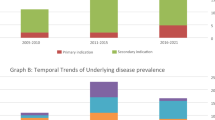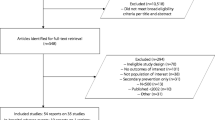Abstract
Background
Implantable cardioverter defibrillators (ICD) are life-saving device therapy, and patients often carry devices for decades with interim pulse generator exchanges. Inappropriate shocks are associated with impaired quality of life and increased mortality, but available data on their incidence and etiology outside of clinical trials is limited and usually restricted to the lifespan of a singular device. We hypothesized that the incidence in clinical practice is underestimated and aimed this study to retrospectively assess the long-term incidence and etiology of inappropriate shocks in a real-world cohort of patients with multiple ICDs over a long follow-up period.
Methods
Patients with ICDs implanted between 1998 and 2012 in two Swiss cardiology departments and at least one device exchange in the same department thereafter were included in this cohort. Retrospective analysis with follow-up until 2016 was conducted to assess incidence and etiology of inappropriate ICD shocks.
Results
Two hundred forty-nine ICDs were implanted in 100 patients (mean age: 60.1 ± 11.7; 80% male). Over a mean follow-up time of 11.2 (± 3.6) years, 555 shocks occurred in 55 patients. One hundred twenty-three (22%) shocks in 23 (23%) patients were inappropriate. Supraventricular arrhythmia and oversensing were the most frequent causes of inappropriate shock. Patients with younger age or previous supraventricular arrhythmias were at increased risk of inappropriate shocks. Patients with inappropriate shocks during the lifespan of their first ICD were at increased risk for inappropriate shocks in subsequent devices.
Conclusions
Inappropriate shocks are an underestimated and frequent problem in clinical practice with an incidence that may exceed numbers of previously reported clinical trials with shorter follow-up periods. Patients at increased risk for inappropriate shocks need careful evaluation of potential therapeutic optimization strategies including pharmacological treatment, device programming, electrophysiological ablation, device downgrading, and telemonitoring.



Similar content being viewed by others
Abbreviations
- ICD:
-
Implantable cardioverter-defibrillator
- IAS:
-
Inappropriate shock
- SD:
-
Standard deviation
- SVT:
-
Supraventricular arrhythmia
References
Huikuri HV, Castellanos A, Myerburg RJ. Sudden death due to cardiac arrhythmias. N Engl J Med. 2001;345(20):1473–82. https://doi.org/10.1056/NEJMra000650.
Brachmann J, Hilbel T, Schols W, Beyer T, Schweizer M, Sterns L, et al. The implantable cardioverter/defibrillator (ICD). Developments up to the present time and future perspectives. Herz. 1994;19(5):246–50.
Moss AJ, Hall WJ, Cannom DS, Daubert JP, Higgins SL, Klein H, et al. Improved survival with an implanted defibrillator in patients with coronary disease at high risk for ventricular arrhythmia. Multicenter Automatic Defibrillator Implantation Trial Investigators. N Engl J Med. 1996;335(26):1933–40. https://doi.org/10.1056/NEJM199612263352601.
The Antiarrhythmics versus Implantable Defibrillators (AVID) Investigators. A comparison of antiarrhythmic-drug therapy with implantable defibrillators in patients resuscitated from near-fatal ventricular arrhythmias. N Engl J Med. 1997;337(22):1576–83.
Moss AJ, Zareba W, Hall WJ, Klein H, Wilber DJ, Cannom DS, et al. Prophylactic implantation of a defibrillator in patients with myocardial infarction and reduced ejection fraction. N Engl J Med. 2002;346(12):877–83. https://doi.org/10.1056/NEJMoa013474.
Kadish A, Dyer A, Daubert JP, Quigg R, Estes NA, Anderson KP, et al. Prophylactic defibrillator implantation in patients with nonischemic dilated cardiomyopathy. N Engl J Med. 2004;350(21):2151–8. https://doi.org/10.1056/NEJMoa033088.
Bardy GH, Lee KL, Mark DB, Poole JE, Packer DL, Boineau R, et al. Amiodarone or an implantable cardioverter-defibrillator for congestive heart failure. N Engl J Med. 2005;352(3):225–37. https://doi.org/10.1056/NEJMoa043399.
van Veldhuisen DJ, Maass AH, Priori SG, Stolt P, van Gelder IC, Dickstein K, et al. Implementation of device therapy (cardiac resynchronization therapy and implantable cardioverter defibrillator) for patients with heart failure in Europe: changes from 2004 to 2008. Eur J Heart Fail. 2009;11(12):1143–51. https://doi.org/10.1093/eurjhf/hfp149.
Priori SG, Blomstrom-Lundqvist C, Mazzanti A, Blom N, Borggrefe M, Camm J, et al. ESC Guidelines for the management of patients with ventricular arrhythmias and the prevention of sudden cardiac death: the Task Force for the Management of Patients with Ventricular Arrhythmias and the Prevention of Sudden Cardiac Death of the European Society of Cardiology (ESC) endorsed by: Association for European Paediatric and Congenital Cardiology (AEPC). Eur Heart J. 2015;36(41):2793–867.
Thomas SA, Friedmann E, Kao CW, Inguito P, Metcalf M, Kelley FJ, et al. Quality of life and psychological status of patients with implantable cardioverter defibrillators. Am J Crit Care. 2006;15(4):389–98.
van Rees JB, Borleffs CJ, de Bie MK, Stijnen T, van Erven L, Bax JJ, et al. Inappropriate implantable cardioverter-defibrillator shocks: incidence, predictors, and impact on mortality. J Am Coll Cardiol. 2011;57(5):556–62. https://doi.org/10.1016/j.jacc.2010.06.059.
Germano JJ, Reynolds M, Essebag V, Josephson ME. Frequency and causes of implantable cardioverter-defibrillator therapies: is device therapy proarrhythmic? Am J Cardiol. 2006;97(8):1255–61. https://doi.org/10.1016/j.amjcard.2005.11.048.
Sweeney MO, Wathen MS, Volosin K, Abdalla I, DeGroot PJ, Otterness MF, et al. Appropriate and inappropriate ventricular therapies, quality of life, and mortality among primary and secondary prevention implantable cardioverter defibrillator patients: results from the Pacing Fast VT REduces Shock ThErapies (PainFREE Rx II) trial. Circulation. 2005;111(22):2898–905. https://doi.org/10.1161/CIRCULATIONAHA.104.526673.
Gasparini M, Proclemer A, Klersy C, Kloppe A, Lunati M, Ferrer JB, et al. Effect of long-detection interval vs standard-detection interval for implantable cardioverter-defibrillators on antitachycardia pacing and shock delivery: the ADVANCE III randomized clinical trial. JAMA. 2013;309(18):1903–11. https://doi.org/10.1001/jama.2013.4598.
Gasparini M, Menozzi C, Proclemer A, Landolina M, Iacopino S, Carboni A, et al. A simplified biventricular defibrillator with fixed long detection intervals reduces implantable cardioverter defibrillator (ICD) interventions and heart failure hospitalizations in patients with non-ischaemic cardiomyopathy implanted for primary prevention: the RELEVANT [role of long dEtection window programming in patients with LEft VentriculAr dysfunction, non-ischemic eTiology in primary prevention treated with a biventricular ICD] study. Eur Heart J. 2009;30(22):2758–67. https://doi.org/10.1093/eurheartj/ehp247.
Steinberg JS, Martins J, Sadanandan S, Goldner B, Menchavez E, Domanski M, et al. Antiarrhythmic drug use in the implantable defibrillator arm of the Antiarrhythmics Versus Implantable Defibrillators (AVID) Study. Am Heart J. 2001;142(3):520–9. https://doi.org/10.1067/mhj.2001.117129.
Gilliam FR, Hayes DL, Boehmer JP, Day J, Heidenreich PA, Seth M, et al. Real world evaluation of dual-zone ICD and CRT-D programming compared to single-zone programming: the ALTITUDE REDUCES study. J Cardiovasc Electrophysiol. 2011;22(9):1023–9. https://doi.org/10.1111/j.1540-8167.2011.02086.x.
Daubert JP, Zareba W, Cannom DS, McNitt S, Rosero SZ, Wang P, et al. Inappropriate implantable cardioverter-defibrillator shocks in MADIT II: frequency, mechanisms, predictors, and survival impact. J Am Coll Cardiol. 2008;51(14):1357–65. https://doi.org/10.1016/j.jacc.2007.09.073.
Theuns DA, Klootwijk AP, Simoons ML, Jordaens LJ. Clinical variables predicting inappropriate use of implantable cardioverter-defibrillator in patients with coronary heart disease or nonischemic dilated cardiomyopathy. Am J Cardiol. 2005;95(2):271–4. https://doi.org/10.1016/j.amjcard.2004.09.017.
Jodko L, Kornacewicz-Jach Z, Kazmierczak J, Rzeuski R, Zielonka J, Kaliszczak R, et al. Inappropriate cardioverter-defibrillator discharge continues to be a major problem in clinical practice. Cardiol J. 2009;16(5):432–9.
Rauwolf T, Guenther M, Hass N, Schnabel A, Bock M, Braun MU, et al. Ventricular oversensing in 518 patients with implanted cardiac defibrillators: incidence, complications, and solutions. Europace. 2007;9(11):1041–7.
Occhetta E, Bortnik M, Magnani A, Francalacci G, Marino P. Inappropriate implantable cardioverter-defibrillator discharges unrelated to supraventricular tachyarrhythmias. Europace. 2006;8(10):863–9.
Moss AJ, Schuger C, Beck CA, Brown MW, Cannom DS, Daubert JP, et al. Reduction in inappropriate therapy and mortality through ICD programming. N Engl J Med. 2012;367(24):2275–83. https://doi.org/10.1056/NEJMoa1211107.
Guedon-Moreau L, Kouakam C, Klug D, Marquie C, Brigadeau F, Boule S, et al. Decreased delivery of inappropriate shocks achieved by remote monitoring of ICD: a substudy of the ECOST trial. J Cardiovasc Electrophysiol. 2014;25(7):763–70. https://doi.org/10.1111/jce.12405.
Klein GJ, Gillberg JM, Tang A, Inbar S, Sharma A, Unterberg-Buchwald C, et al. Improving SVT discrimination in single-chamber ICDs: a new electrogram morphology-based algorithm. J Cardiovasc Electrophysiol. 2006;17(12):1310–9. https://doi.org/10.1111/j.1540-8167.2006.00643.x.
Duru F, Bauersfeld U, Candinas R. Avoiding inappropriate ventricular tachycardia detection due to T-wave oversensing in an implantable cardioverter defibrillator: a novel application of the electrogram width criterion. Europace. 2001;3(1):80–4.
Kleemann T, Becker T, Doenges K, Vater M, Senges J, Schneider S, et al. Annual rate of transvenous defibrillation lead defects in implantable cardioverter-defibrillators over a period of >10 years. Circulation. 2007;115(19):2474–80. https://doi.org/10.1161/CIRCULATIONAHA.106.663807.
Author information
Authors and Affiliations
Corresponding author
Ethics declarations
The study was conducted according to the principles expressed in the Declaration of Helsinki of 1964, as revised in 2013, and was in accordance with the ethical standards of the responsible committee on human experimentation (institutional and national). Patient consent was not required, since data was collected and analyzed retrospectively as well as anonymously, and there were no new procedural studies undertaken due to the retrospective study design. This article does not contain any new studies with human subjects performed by any of the authors. The local ethical committee (Kantonale Ethikkomission Zürich) approved the study in advance.
Authorship
All named authors meet the International Committee of Medical Journal Editors (ICMJE) criteria for authorship for this manuscript, take responsibility for the integrity of the work as a whole, and have given final approval to the version to be published.
Disclosures
Dr. Hofer reports educational and travel funds from St. Jude Medical and Biosense Webster. Dr. Krasniqi and Prof. Eriksson report research grants and educational funds from Boston Scientific, St. Jude Medical, Medtronik, and Biotronik. Dr. Hürlimann reports speaker honoraria and consulting fees from Biotronik, Boston Scientific, LivaNova, Medtronic, and St. Jude Medical. Dr. Haegeli reports speaker honoraria and consulting fees from St. Jude Medical. Dr. Steffel has received consultant and/or speaker fees from Amgen, Astra-Zeneca, Atricure, Bayer, Biosense Webster, Biotronik, Boehringer-Ingelheim, Boston Scientific, Bristol-Myers Squibb, Cook Medical, Daiichi Sankyo, Medtronic, Novartis, Pfizer, Sanofi-Aventis, Sorin, St. Jude Medical, and Zoll. Dr. Steffel is co-director of CorXL. He has received grant support through his institution from Bayer Healthcare, Biosense Webster, Biotronik, Boston Scientific, Daiichi Sankyo, Medtronic, and St. Jude Medical. Prof. Duru reports institutional funds from Boston Scientific, Biotronik, St. Jude Medical, Biosense Webster, and Medtronic. All other authors report no relationships to disclose.
Rights and permissions
About this article
Cite this article
Hofer, D., Steffel, J., Hürlimann, D. et al. Long-term incidence of inappropriate shocks in patients with implantable cardioverter defibrillators in clinical practice—an underestimated complication?. J Interv Card Electrophysiol 50, 219–226 (2017). https://doi.org/10.1007/s10840-017-0297-8
Received:
Accepted:
Published:
Issue Date:
DOI: https://doi.org/10.1007/s10840-017-0297-8




